Uncategorized
Wrist Physical Therapy – 3 Types of Exercises for Strong Wrists
Wrist Physical Therapy – Effective Exercises for Rehabilitation & Strengthening
As one of the most active joints in the body, the wrist can be very susceptible to injury. Fractures, sprains, tendonitis, tenosynovitis, ligament tears, breaks… the list goes on – there are so many different types of wrist injuries that affect people today. But no matter what your injury, it is important to make sure that you rehabilitate fully by practicing effective wrist physical therapy.
Wrist Physical Therapy Made Simple with Powerball
There are a variety of techniques and exercises that are effective for wrist physical therapy. Range of motion exercises along with stretching and strengthening exercises will most likely be recommended by your doctor or physiotherapist to help you rehabilitate and re-train your wrist after injury. While these types of exercises are very beneficial, we recommend that you supplement them with isometric exercise in order to achieve maximum recovery results.
Powerball is one of the most effective isometric exercisers in the world. At only the size of an apple, Powerball is a physician-approved gyroscope that is used by over 4 million people worldwide to effectively rehabilitate and strengthen their upper-body limbs.
Experience the results for yourself – spin Powerball for just 3 minutes a day to benefit from fast and effective wrist physical therapy.
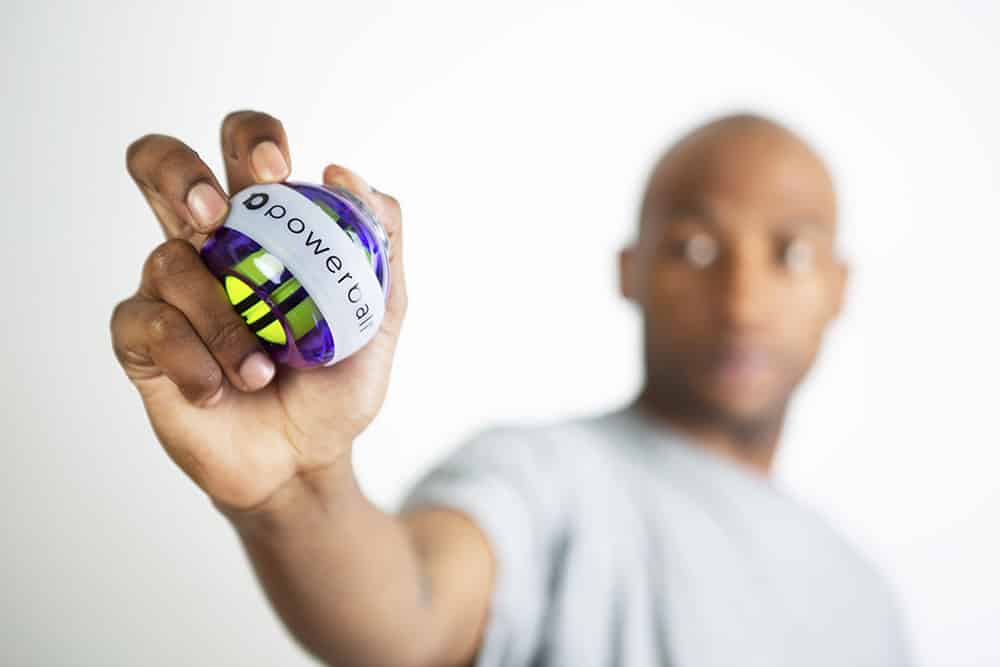
Continue reading for recommended wrist physical therapy exercises and more information on Powerball’s incredible rehabilitation benefits.
Wrist Physical Therapy for Specific Injuries
Because there are so many different types of wrist injuries, there are also different forms of wrist injury rehabilitation. Some wrist injuries, such as RSI (carpal tunnel syndrome and tendonitis), will heal themselves over time, while others require that you wear a cast or splint on your wrist for a couple of weeks (breaks, fractures, sprains) before beginning any kind of therapy.
Very severe wrist injuries may even require surgery, but no matter what kind of wrist injury you have, all injuries will benefit from wrist strengthening exercises at some point during your recovery.
Click on the links below for more information on wrist physical therapy for specific injuries:
- Wrist breaks, fractures & sprains
- Wrist Tendonitis (RSI)
- De Quervain’s Tenosynovitis
- Carpal Tunnel Syndrome
- Osteoarthritis
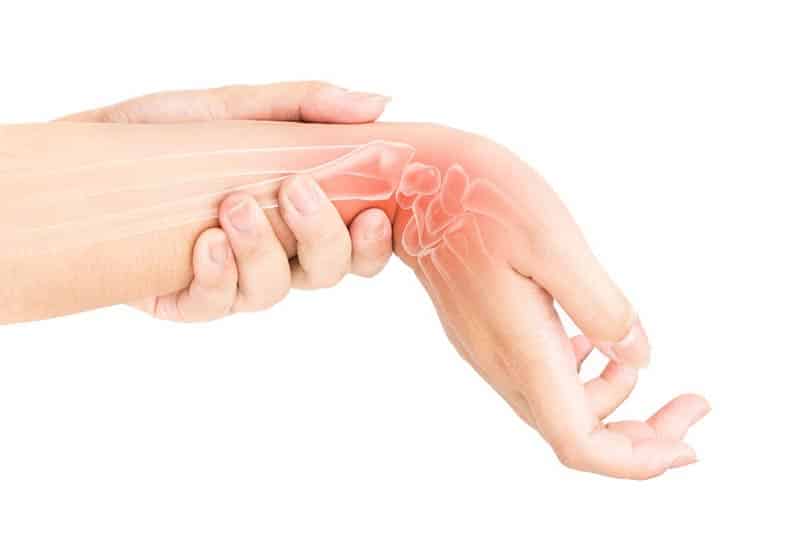
Beneficial Exercises for Wrist Physical Therapy
Once you have fully healed from your wrist injury, you can start regaining strength and movement in your wrist as part of your wrist physical therapy. To be clear, you should only ever begin wrist physical therapy AFTER your injury has fully healed (i.e bones/tears/fractures are fully repaired and you no longer experience intense pain when moving the wrist joint.) It is recommended that you visit your doctor if you are unsure about when to start wrist physical therapy.
Even after your injury has properly healed, your muscles, tendons and bones will likely be very weak. That is why is it important to start slowly and gradually build the intensity of your wrist physical therapy as you progress through your recovery.
Stage 1 – Range of motion exercises
Range of motion exercises require simple movements of the wrist and are a good place to start when you begin wrist physical therapy. These types of exercises slowly take the wrist through its normal range of motion and should be done gently and carefully to avoid further injury. Below are three examples of simple range of motion exercises. Each exercise should be done 10 times (10 reps), which should be repeated 3 times daily.
Beneficial for: Most wrist injuries, including wrist RSI (carpal tunnel syndrome & tendonitis), wrist fractures & breaks, wrist sprains, de Quervain’s tenosynovitis and more.
Always take care to never overexert yourself. If it hurts, take a break! It is advised that you seek medical attention if you experience severe pain or numbness after or during these exercises.
1. Wrist extension and flexion
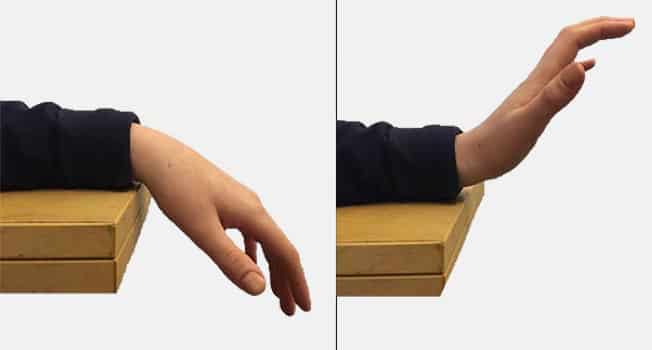
With your forearm resting on a table, have your hand hanging over the ledge with your palm facing down.
Gently move your hand upward until you feel a gentle stretch. Lower your hand again to the starting position.
Repeat this exercise 10 times, 3 times a day.
2. Palm turning exercise
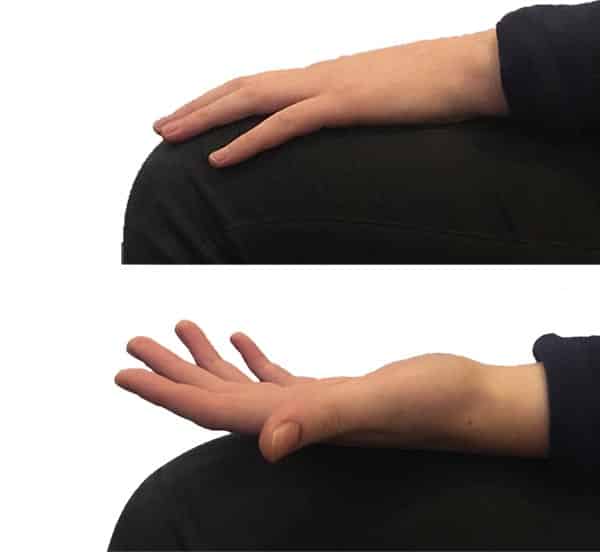
While seated, lay your hand flat on your leg with your palm facing down. Gently turn your hand over, so that the palm is facing up.
Repeat this exercise 10 times, 3 times a day.
3. Opening and closing fist

Begin with your fist closed (not too tightly). Slowly open your palm, stretching your fingers outwards.
Close your fist again. Repeat this exercise 10 times, 3 times a day.
Stage 2 – Stretching exercises
Wrist stretching exercises are a step further in wrist physical therapy. As the name suggests, these types of exercises stretch out the muscles and tendons in the wrist and forearm, increasing circulation and overall flexibility. Below are four examples of simple, yet effective stretching exercises for wrist physical therapy.
1. Wrist stretch (palm inwards)
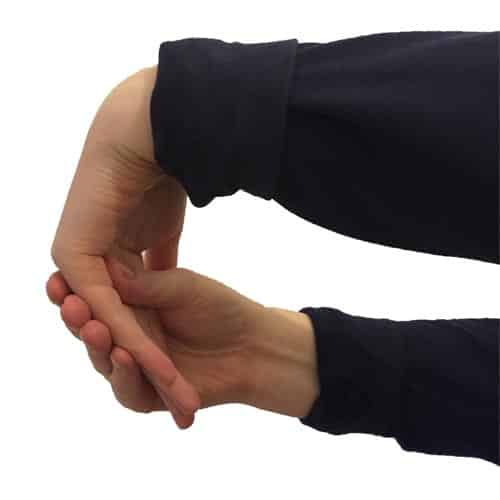
Begin with your arm outstretched in front of you with your palm facing in towards your body and your fingers pointing towards the floor.
With your free hand, grab the fingers of your outstretched hand and gently pull them towards you until you feel a gentle stretch in the back of your wrist.
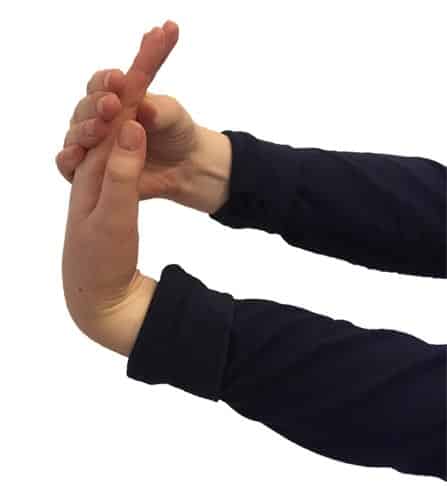
Hold the stretch for 10-20 seconds.
Repeat this exercise again, but this time have your fingers facing up towards the ceiling with your palm still facing in towards your body.
Repeat this exercise 3 times a day.
2. Wrist stretch (palm outwards)
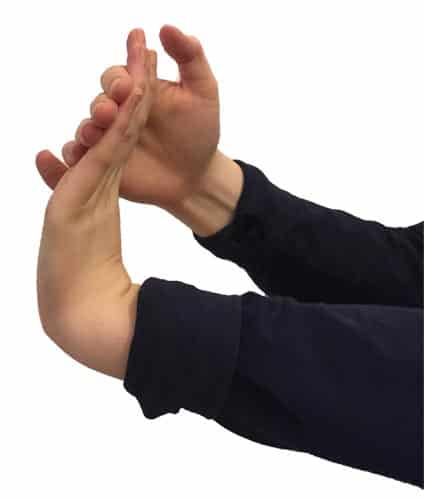
This exercise is the exact same as the one above, except that this time, your palm is facing outwards, away from your body throughout the exercise.
Repeat 3 times daily.

Both of the above exercises can be performed using a table (as illustrated above).
Place both of your palms face down on the edge of a table. Keeping your elbows straight, gently lean your body weight forward. Hold this position for 10-20 seconds.
Repeat this exercise 3 times.
Afterwards, turn your hands so that the palms are facing upwards towards the ceiling. Repeat the same movements as above (repeat 3 times).
3. Palm press (thumbs in)

While standing, bring your hands together in a praying position.
Raise your hands until they are level with your face and bring your elbows together.
Keeping them joined, slowly start to lower your hands until you begin to feel a gentle stretch (this is usually felt as your hands draw level with the belly button).
Hold the stretch for 10-20 seconds. Repeat this exercise 3 times daily.
4. Palm press (thumbs out)
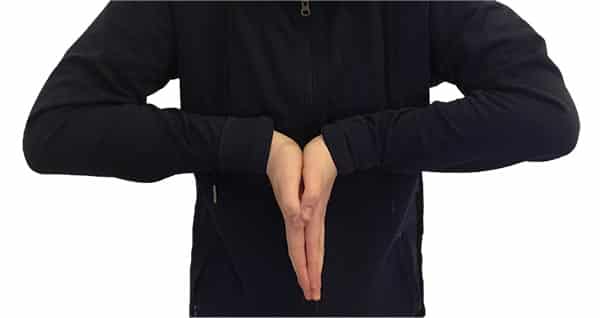
Bring your hands together in a praying position, level with your belly button. Now turn your hands downwards, so that your fingers are pointing down towards the floor (thumbs are facing outwards).
Slowly bring your hands up towards your chest until you feel a gentle stretch.
Hold the stretch for 10-20 seconds. Repeat 3 times daily.
Stage 3 – Strengthening Exercises
Once you can do all of the range of motion and stretching exercises without feeling any pain, you can move on to strengthening exercises. Strengthening exercises are the final stage of your wrist physical therapy and will effectively strengthen the wrist joint for a longer-lasting, more effective recovery. Stronger, healthier wrists are more flexible and resilient, and are less likely to incur injury in the future.
Practicing regular strengthening exercises maintains muscle and joint health and so, it is recommended that you continue to practice the below exercises even after you have fully regained strength in your wrist.
1. wrist extension exercise
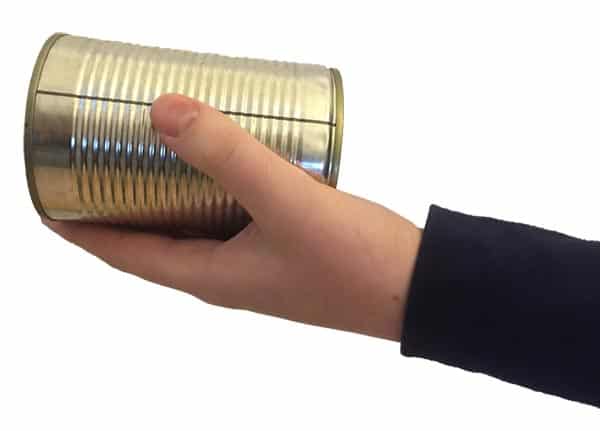
Holding a can or light dumbbell in your hand, bend your elbow at a 90-degree angle. (You may also support your arm on a table to do this exercise if it is easier.) Ensure that the hand holding the weight is facing upwards, (palm facing towards the ceiling).
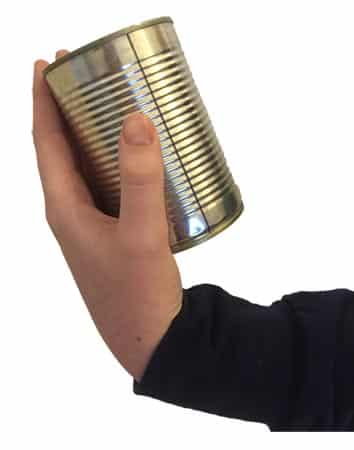
Now, keeping your elbow bent, slowly raise your hand upwards (towards your body) until you feel a gentle stretch.
Hold this position for 10-20 seconds, then bring your hand back to the starting position.
Repeat this exercise 10 times, 3 times a day.
As you feel yourself becoming stronger, you can gradually increase the weight of the can/dumbbell.
2. Wrist flexion exercise
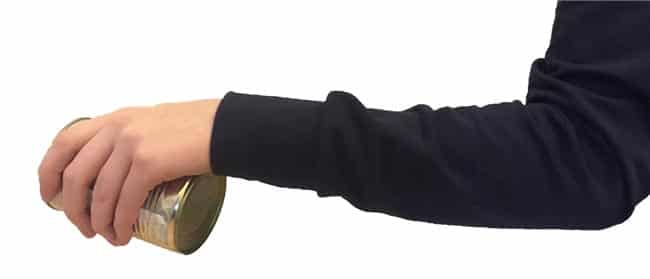
This exercise is the exact same as the one above, except that this time, the hand holding the weight is positioned with the palm facing down towards the floor.
With your elbow bent at a 90-degree angle, hold the weight in your hand. Slowly raise your hand upwards, bending your wrist until you feel a gentle stretch.
Hold this position for 10-20 seconds, then bring your hand back to the starting position.
Repeat this exercise 10 times, 3 times a day.
As you feel yourself becoming stronger, you can gradually increase the weight of the can/dumbbell.
3. Grip strengthening
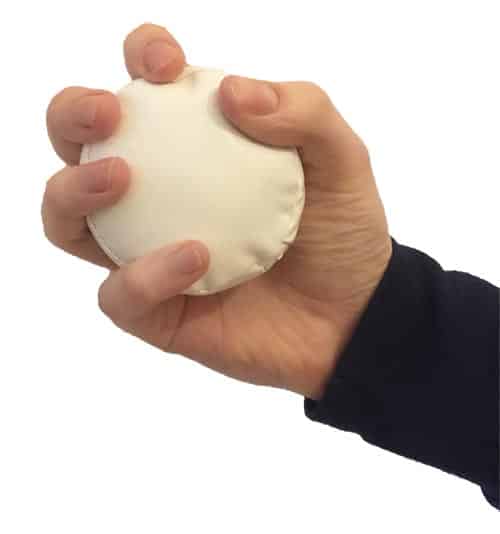
For this exercise you need a soft, rubber ball, such as a stress ball or hard sponge.
Grip the ball in your hand with your fingers all around it.
Gently begin squeezing the ball. There are two types of exercises you can do here:
1. Give the ball 10 short squeezes with your hand – squeezing, then immediately loosening your grip. Repeat this 3 times (10 reps x 3).
– or –
2. Squeeze the ball and hold for 10 seconds. Then release. Repeat this exercise 3 times.
Powerball® Strengthening Accessories for Wrist Physical Therapy
We offer a wide range of diverse strengthening accessories to aid you with each step of your wrist physical therapy. While our strengtheners are a step up from the above exercises, we still recommend using them in conjunction with these exercises to benefit from maximum recovery results. You can check out the range of strengthening accessories available below or in our online store:
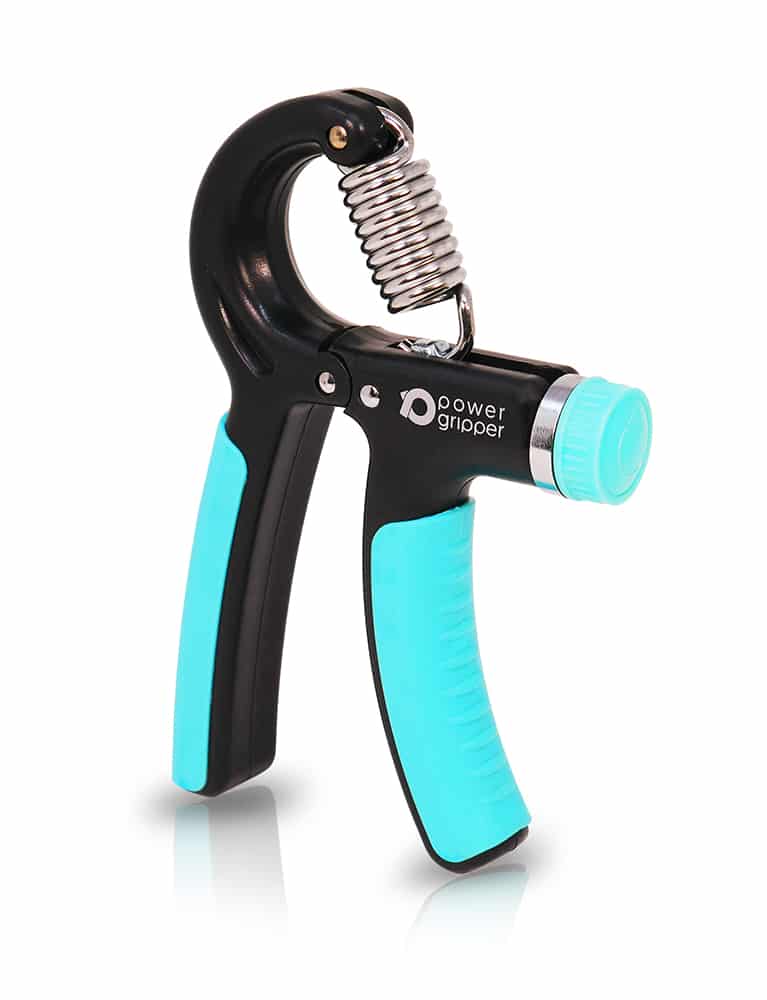
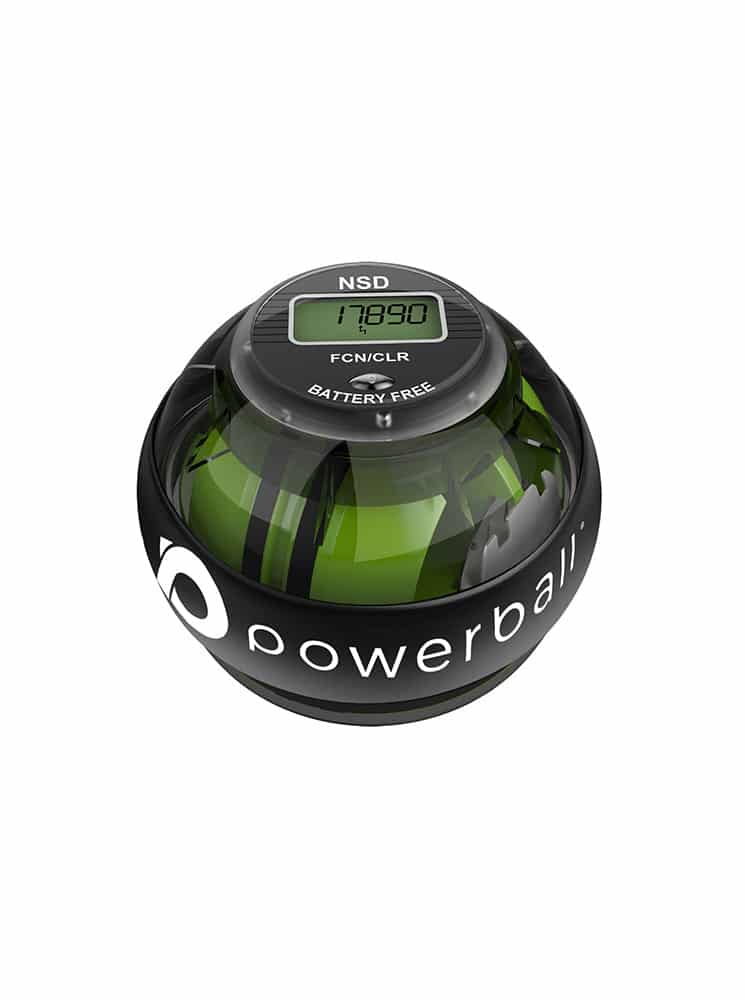
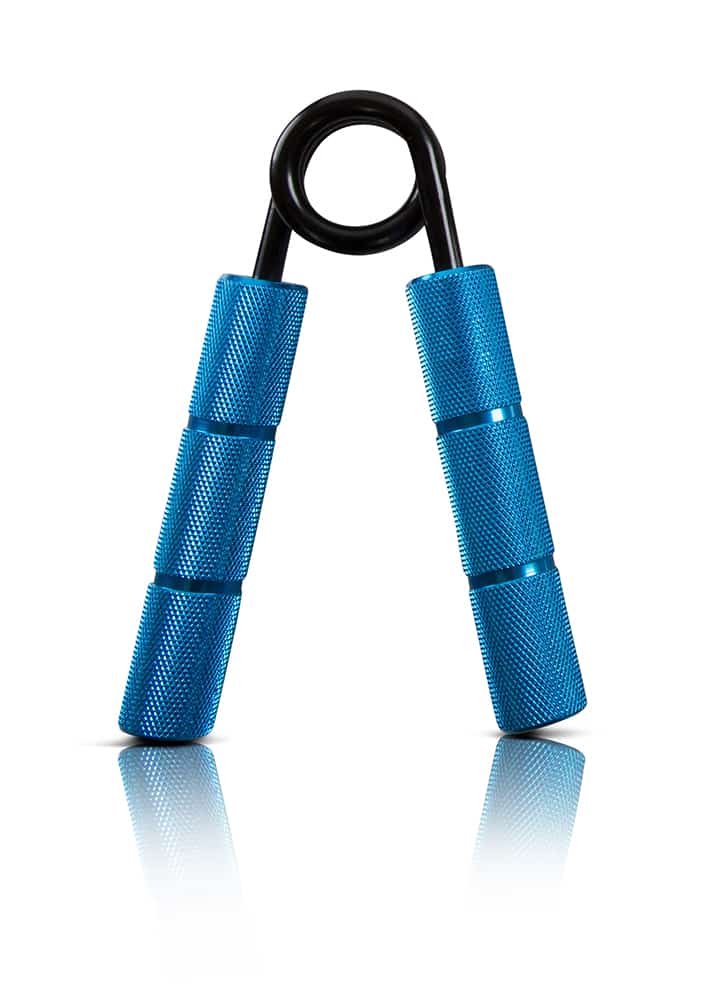
Adjustable Powergripper®
Powerball® 280Hz Autostart Pro
PowerGripper® Blue 150lb (Medium)
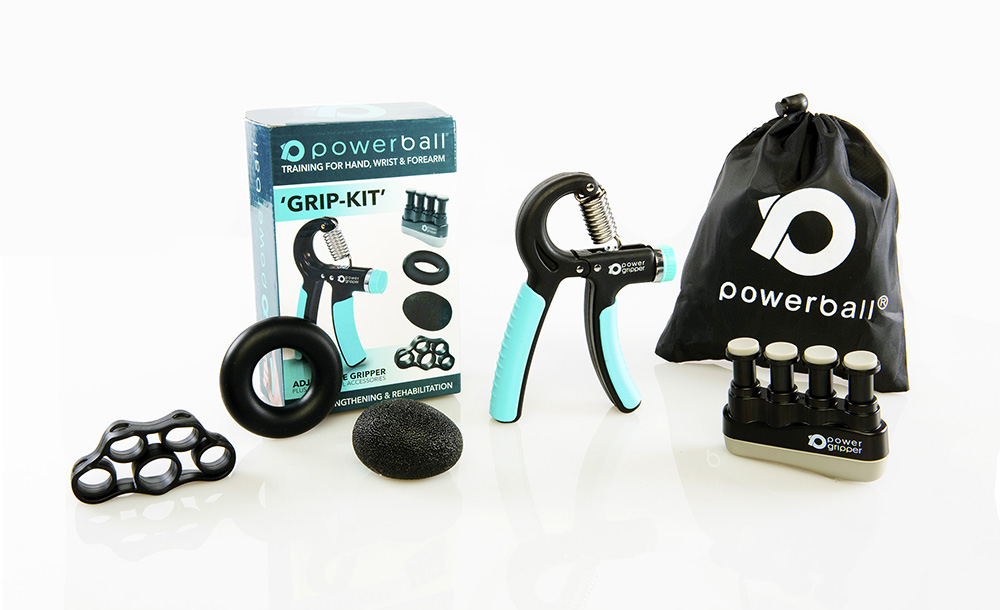
Isometric Exercise for Effective Wrist Physical Therapy
sometric exercise differs from concentric and eccentric exercise (the exercises outlined above), because it does not involve a change in muscle length or joint angle. With other types of exercises, the muscle lengthens (eccentric) or shortens (concentric), but isometric exercise keeps the muscle stationary. However, this does not mean that your muscles aren’t working hard when engaged in isometric exercise. In fact the opposite is true: isometric exercise works your muscles from their very core, building strength and endurance faster than any other form of exercise.
http://https://www.youtube.com/watch?v=qsuYila31qsI
Powerball for Wrist Physical Therapy
Powerball is a simple, handheld gyroscope yet, is one of the world’s most effective isometric exercisers. Powerball generates healing isometric resistance as you spin it – the faster you spin, the more resistance it creates. Powerball’s isometric exercise engages your muscles from fingertip to shoulder and is thus, highly effective for rehabilitation, strengthening and wrist physical therapy.
Start spinning with Powerball today and see for yourself why over 4 million people worldwide have benefited from using this unique product.
Rehabilitate wrist injuries
The intensity of your exercise with Powerball can be as gentle or as powerful as you like – you control the speed of your recovery. For effective rehabilitation results, we always recommend starting at low spin speeds and gradually building intensity as you grow stronger.
Even at low spin speeds, Powerball’s isometric resistance still massively increases circulation throughout the entire kinetic chain of the arm, bringing healing, oxygen-rich nutrients to damaged tissue in the wrist. These nutrients act fast to relieve any pain and repair and rejuvenate injured muscles, tendons and bones. And that’s not even the best part…

Strengthen as you recover
Powerball is so effective for wrist physical therapy because of its ability to build strength and rehabilitate at the same time. As your muscles and tendons are healing, they are also fully engaged by Powerball’s isometric resistance. This resistance delves deep into tissue fibres, actively strengthening your muscles as you recover. This dual action of strengthening and rehabilitation dramatically cuts recovery times and promotes long-lasting rehabilitation results that go muscle-deep.

Increase wrist flexibility & range of motion
Reduce stiffness, enhance flexibility and increase circumduction (range of motion) in the wrist joint – it’s as easy as spinning Powerball. Exercising with Powerball increases the production of synovial fluid with lubricates the wrist joint. This in turn reduces any pain and stiffness caused by injury and allows you to gain power, increase flexibility and recover strength in the wrist. All it takes is 3 minutes a day with Powerball to start seeing the benefits of this unique gyroscope.
100% non-impact wrist physical therapy
If you haven’t already guessed, the secret to Powerball is it’s healing isometric resistance. Isometric resistance is 100% non-impact, meaning it doesn’t place any extra strain on sore muscles or tendons in the wrist. What’s more, Powerball requires very little effort to start and spin. Many of our models are fitted with an Autostart mechanism for even greater ease of use. (You can check out our video tutorials on how to start your Powerball here.) With this in mind, you need never worry about overexerting yourself or worsening your injury when you exercise with Powerball.
Prevent future injury
Spin Powerball for as little as 3 minutes each day to benefit from effective injury protection. Think of it as an extra layer of body armour for your wrists: as you exercise, Powerball’s unique isometric resistance works its way along the entire arm, actively strengthening and preventing injury from fingertip to shoulder. Combat the symptoms of RSI, weak wrists or a reoccurring injury simply by spinning Powerball. It has never been easier to keep your wrists strong, healthy and pain-free.
Combine regular Powerball exercise with the exercises outlined above to benefit from fast and effective wrist physical therapy. No matter what your injury, get back to a healthy and active lifestyle today with Powerball. Click on the button below to check out the range of models and strengthening accessories that are available in our online store.
Physio-Designed Programmes for Wrist Physical Therapy
Here at Powerball we’ve worked closely with physiotherapists and sports injury specialists to create a variety of easy-to-follow video programmes for your wrist physical therapy. Following these exercise programmes will massively benefit your recovery process by providing you with a step-by-step guide to effective wrist rehabilitation. Check out our videos page to see our range of exercise programmes or watch the videos below for information on helpful wrist rehab exercises.
CLIMBER’S ELBOW OR GOLFER’S ELBOW? POWERBALL IT AWAY
I’ve been suffering with Golfers Elbow for some time and use my Powerball when it gets really uncomfortable, I exercise with Powerball for a couple of minutes then, as if by magic the aches ease away and my arm is trouble free for about a week. No permanent cure yet, but 2 weeks totally rested and filled with Ibuprofen didn’t provide a medical cure either. At least this Powerball gives me around a week of pain relief for a couple of minutes of exercise, and virtually instant too.
5 Star Amazon Review






